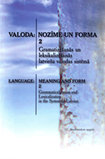Palīgnozīmē lietoti darbības vārdi bērnu valodā
Verbs Used as Auxiliaries in Children’s Language
Author(s): Baiba IvulāneSubject(s): Language and Literature Studies, Theoretical Linguistics, Baltic Languages
Published by: Latvijas Universitātes Akadēmiskais apgāds
Keywords: patstāvīgs darbības vārds; palīgdarbības vārds; saitiņa; modificētājs; bērnu valoda;
Summary/Abstract: In the article, grammatical functions of Latvian verbs are discussed, especially focusing on the verbs used as auxiliaries – auxiliary verbs themselves, as well as copulas and modal verbs. The basis of such distinction of verb groups in Latvian is the process of grammaticalization, as the auxiliaries were initially used as independent verbs. This is proved also by the use of these verbs in children’s language.The aim of this study is to state which grammatical functions of verbs exist in children’s language and to find out which of them is acquired first and which ones later, as well as to analyze auxiliary verb constructions that are characteristic only to children’s language. The problems of such research are also stated – the main of them being an insufficient amount of Latvian children’s language material that can be widely accessed for this kind of research. To be able to objectively analyze the way grammatical system of children’s language develop, first several overall studies on the language acquisition of a separate child should be done.In the article, it is concluded that the grammatical functions of verbs are the same both in children’s language, as well as in fully formed language. The first ones to be acquired in children’s language are independent verbs. Auxiliary verbs and other groups are acquired later on, the first of them being the ones that are most frequently used in their parents’ language. The sequence of how these verbs appear in children’s language is as follows: copula būt ‘be’, modal verbs gribēt ‘want’, vajadzēt ‘need’, varēt ‘can’, auxiliary verb būt ‘be’ (first in the indicative analytic present forms with the other forms following much later). There are also constructions with auxiliary verbs used in the children’s language that are not characteristic to fully formed language.
Journal: Valoda: nozīme un forma
- Issue Year: 2012
- Issue No: 2
- Page Range: 75-85
- Page Count: 11
- Language: Latvian

